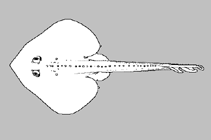Dentiraja endeavouri (Last, 2008)
Endeavour skate
Upload your photos and videos
Google imageNo image available for this species;
drawing shows typical species in Rajidae.
Google imageNo image available for this species;
drawing shows typical species in Rajidae.
Classification / Names Nomi Comuni | Sinonimi | Catalog of Fishes(Genere, Specie) | ITIS | CoL | WoRMS | Cloffa
Elasmobranchi (squali e razze) (sharks and rays) > Rajiformes (Skates and rays) > Rajidae (Skates)
Etymology: endeavouri: Named for the ill-fated 'F.I.S. Endeavour'.
Eponymy: These species are named after the fisheries investigation steamship ‘Endeavour’ that was lost with all hands off the coast of Australia (1914). [...] (Ref. 128868), visit book page.
More on author: Last.
Etymology: endeavouri: Named for the ill-fated 'F.I.S. Endeavour'.
Eponymy: These species are named after the fisheries investigation steamship ‘Endeavour’ that was lost with all hands off the coast of Australia (1914). [...] (Ref. 128868), visit book page.
More on author: Last.
Environment: milieu / climate zone / depth range / distribution range Ecologia
; salmastro benthopelagico; distribuzione batimetrica 110 - 370 m (Ref. 114953). Tropical; 27°S - 33°S, 152°E - 155°E (Ref. 114953)
Distribuzione Stati | Aree FAO | Ecosystems | Presenze | Point map | Introduzioni | Faunafri
Southwest Pacific: off eastern Australia
Size / Peso / Age
Maturity: Lm ? range ? - ? cm
Max length : 32.1 cm TL maschio/sesso non determinato; (Ref. 75648); 36.7 cm TL (female)
Max length : 32.1 cm TL maschio/sesso non determinato; (Ref. 75648); 36.7 cm TL (female)
Occurs mainly on the outer continental shelf and upper slope, recorded up to 500 m. Diet mainly based on crustaceans; juveniles feed on amphipods and carid shrimps while adults feed on prawns and bony fishes (Ref. 114953). Lengths of adolescent males unknown, but largest juvenile male was 23.4 cm TL, adult males 31.5-32.1 cm TL, with smallest juvenile 17.0 cm TL (Ref. 75648). Females mature at ca. 31 cm TL; young hatch at 10-11 cm TL (Ref. 114953).
Life cycle and mating behavior Maturità | Riproduzione | Deposizione | Uova | Fecundity | Larve
Main reference
Upload your references | Bibliografia | Coordinatore : McEachran, John | Collaboratori
Last, P.R., 2008. New short-snout members of the skate genus Dipturus (Rajoidei: Rajidae) from Australian seas. pp. 53-98. In Last, P.R., W.T. White, J.J. Pogonoski and D.C. Gledhill (eds.): Descriptions of new Australian skates (Batoidea: Rajoidei) pg. 53-98. CSIRO marine and atmospheric research paper no. 021. (Ref. 75648)
IUCN Red List Status (Ref. 130435: Version 2024-2)
Near Threatened (NT) (A2d); Date assessed: 09 February 2021
CITES
Not Evaluated
Threat to humans
Harmless
Human uses
FAO - Publication: search | FishSource |
Informazioni ulteriori
Population dynamics
Growth parameters
Max. ages / sizes
Length-weight rel.
Length-length rel.
Length-frequencies
Mass conversion
Reclutamento
Abbondanza
Growth parameters
Max. ages / sizes
Length-weight rel.
Length-length rel.
Length-frequencies
Mass conversion
Reclutamento
Abbondanza
Life cycle
Riproduzione
Maturità
Maturity/Gills rel.
Fecundity
Deposizione
Spawning aggregations
Uova
Egg development
Larve
Dinamica popolazioni larvali
Riproduzione
Maturità
Maturity/Gills rel.
Fecundity
Deposizione
Spawning aggregations
Uova
Egg development
Larve
Dinamica popolazioni larvali
Anatomy
Area branchiale
Brain
Otolith
Area branchiale
Brain
Otolith
Physiology
Body composition
Nutrients
Oxygen consumption
Swimming type
Swimming speed
Visual pigments
Fish sound
Diseases & Parasites
Toxicity (LC50s)
Body composition
Nutrients
Oxygen consumption
Swimming type
Swimming speed
Visual pigments
Fish sound
Diseases & Parasites
Toxicity (LC50s)
Genetics
Genetica
Heterozygosity
Ereditarietà
Genetica
Heterozygosity
Ereditarietà
Human related
Aquaculture systems
Profili di acquacoltura
Varietà
Ciguatera cases
Stamps, coins, misc.
Aquaculture systems
Profili di acquacoltura
Varietà
Ciguatera cases
Stamps, coins, misc.
Strumenti
E-book | Giuda pratica | Generatore frequenze di lunghezza | Strumento Parametri Biologici | Mappa dei ritrovamenti | Classification Tree
| Catch-MSY |
Special reports
Download XML
Fonti Internet
AFORO (otoliths) | Aquatic Commons | BHL | Cloffa | BOLDSystems | Websites from users | Check FishWatcher | CISTI | Catalog of Fishes: Genere, Specie | DiscoverLife | ECOTOX | FAO - Publication: search | Faunafri | Fishipedia | Fishtrace | GenBank: genome, nucleotide | GloBI | Google Books | Google Scholar | Google | IGFA World Record | MitoFish | Otolith Atlas of Taiwan Fishes | PubMed | Reef Life Survey | Socotra Atlas | Tree of Life | Wikipedia: Go, ricerca | World Records Freshwater Fishing | Zoological Record
Estimates based on models
Phylogenetic diversity index (Ref. 82804): PD50 = 0.5010 [Uniqueness, from 0.5 = low to 2.0 = high].
Bayesian length-weight: a=0.00302 (0.00141 - 0.00645), b=3.24 (3.07 - 3.41), in cm total length, based on LWR estimates for this (Sub)family-body shape (Ref. 93245).
Trophic level (Ref. 69278): 4.0 ±0.6 se; based on size and trophs of closest relatives
Resilienza (Ref. 120179): Basso, tempo minimo di raddoppiamento della popolazione 4.5 - 14 anni (Preliminary low fecundity).
Fishing Vulnerability (Ref. 59153): Low to moderate vulnerability (27 of 100).




